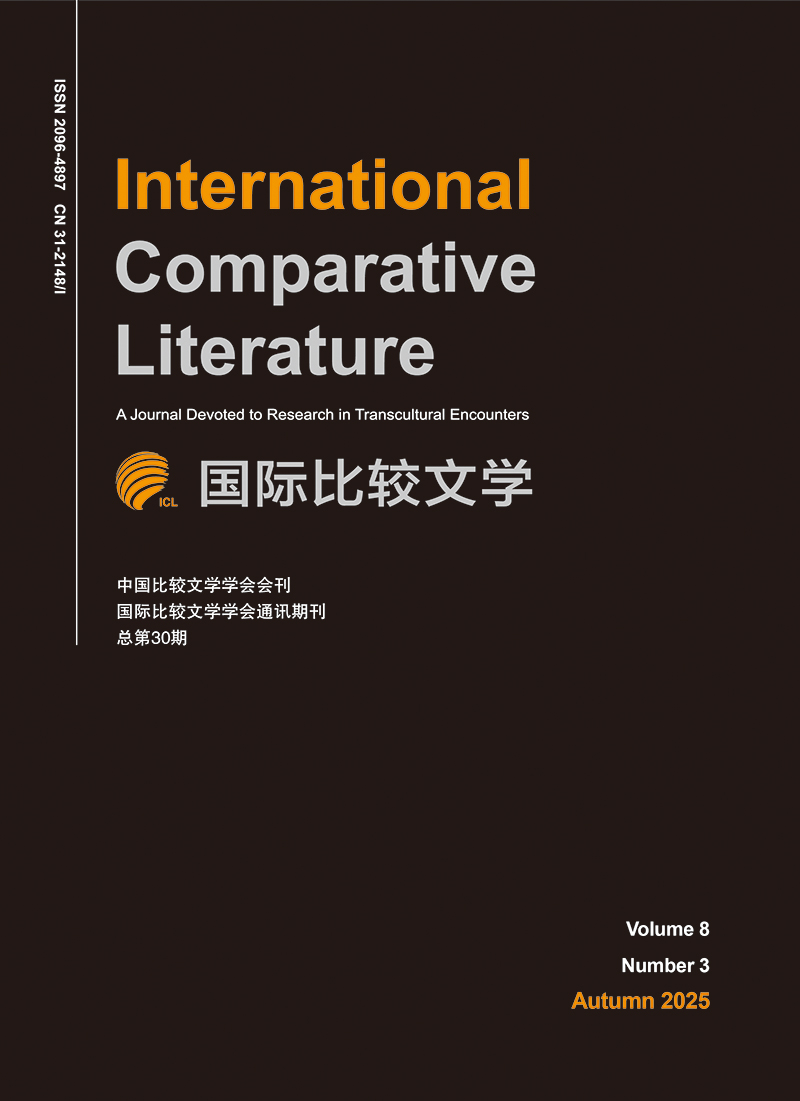|
[1]
|
Ames,Roger T.Wandering at Ease in the Zhuangzi.Albany:State University of New York,1998.
|
|
[2]
|
Anderson,Charles Roberts.Emily Dickinson’s Poetry:Stairway of Surprise.New York:Holt,Rinehart and Winston,1960.
|
|
[3]
|
Bachelard,Gaston,M.Jolas,and John R.Stilgoe.The Poetics of Space.Boston:Beacon,1994.
|
|
[4]
|
Bloom,Harold.Genius:A Mosaic of One Hundred Exemplary Creative Minds.New York:Warner,2002.
|
|
[5]
|
Cameron,Sharon.Lyric Time:Dickinson and the Limits of Genre.Baltimore:Johns Hopkins University Press,1979.
|
|
[6]
|
CHEN Shudong.“Emily Dickinson,Function Words,and Dao:A Prosodic and Philosophical View from across Cultures.”
|
|
[7]
|
Cowrie:A Journal of Comparative Literature and Culture 1(2015):43-87.
|
|
[8]
|
CHONG Kim-chong.“Zhuangzi’s Cheng Xin and Its Implications for Virtue and Perspectives.” Dao 10,no.4(2011):427-
|
|
[9]
|
43.Web.
|
|
[10]
|
Connolly,Tim.“Perspectivism as a Way of Knowing in the Zhuangzi.” Dao 10,no.4(2011):487-505.Web.
|
|
[11]
|
Dickinson Electronic Archives.Accessed February 1,2019.http://archive.emilydickinson.org.
|
|
[12]
|
Dickinson,Emily.The Poems of Emily Dickinson.3 vols.Edited by R.W.Franklin.Cambridge,MA:Harvard University
|
|
[13]
|
Press,1998.(Citation by poem number.)
|
|
[14]
|
Diehl,Joanne Feit.Dickinson and the Romantic Imagination.Princeton,NJ:Princeton University Press,1981.
|
|
[15]
|
Eberwein,Jane Donahue.Dickinson:Strategies of Limitation.Amherst:The University of Massachusetts Press,1985.
|
|
[16]
|
Eliot,T.S.,Anne Hodgson,and Philip Mairet.Little Gidding.London:Faber and Faber,1942.
|
|
[17]
|
Epley,Nicholas,Adam Waytz,and John T.Cacioppo.“On Seeing Human:A Three-Factor Theory of Anthropomorphism.”
|
|
[18]
|
Psychological Review 114,no.4(2007):864-86.
|
|
[19]
|
Frye,Northrop.Fables of Identity:Studies in Poetic Mythology.New York:Harcourt,Brace&World,1963.
|
|
[20]
|
Gelpi,Albert.Emily Dickinson:The Mind of the Poet.Cambridge:Harvard University Press,1965.
|
|
[21]
|
Gelpi,Albert,and William Robert Sherwood.“Circumference and Circumstance:Stages in the Mind and Art of Emily
|
|
[22]
|
Dickinson.” American Literature 40,no.4(1969):557.Web.
|
|
[23]
|
Gerhardt,Christine.“‘Often Seen-but Seldom Felt’:Emily Dickinson’s Reluctant Ecology of Place.” The Emily
|
|
[24]
|
Dickinson Journal 15,no.1(2006):56-78.Web.
|
|
[25]
|
Gillespie,Robert.“A Circumference of Emily Dickinson.” The New England Quarterly 46,no.2(1973):250-71.Web.
|
|
[26]
|
Gould,S.J.“Can We Truly Know Sloth and Rapacity?” In Leonardo’s Mountain of Clams and the Diet of Worms.New
|
|
[27]
|
York:Three River Press,1998,375-91.
|
|
[28]
|
Griffith,Clark.The Long Shadow:Emily Dickinson’s Tragic Poetry.Princeton,NJ:Princeton University Press,1964.
|
|
[29]
|
Hall,David L.,and Roger T.Ames.Thinking through Confucius.Albany:State University of New York,1987.
|
|
[30]
|
KANG Yanbin.“Dickinson’s Hummingbirds,Circumference,and Chinese Poetics.” The Emily Dickinson Journal 20,no.2
|
|
[31]
|
(2011):57-82.Web.
|
|
[32]
|
——.“Dickinson’s‘ Power to Die’ from a Transcultural Perspective.” The Emily Dickinson Journal 22,no.2(2013):
|
|
[33]
|
65-85.Web.
|
|
[34]
|
——.“Towards a Chinese Perspective on Dickinson.” Literature Compass 11,no.3(2014):149-58.Web.
|
|
[35]
|
——.“Dickinson’s Drunkard as an Archetypical Sage.” The Explicator 73,no.3(2015):206-9.Web.
|
|
[36]
|
——.“Dickinson’s Allusions to Thoreau’s East.” ANQ:A Quarterly Journal of Short Articles,Notes and Reviews 29,
|
|
[37]
|
no.2(2016):92-97.
|
|
[38]
|
——.“Emily Dickinson and Represented Buddhism in Nineteenth Century America.” English Studies:A Journal of
|
|
[39]
|
English Language and Literature 98,no.2(2017):1-22.
|
|
[40]
|
Keane,Patrick J.Emily Dickinson’s Approving God:Divine Design and the Problem of Suffering.Columbia:University of
|
|
[41]
|
Missouri,2008.
|
|
[42]
|
Kohler,Michelle.Miles of Stare:Transcendentalism and the Problem of Literary Vision in Nineteenth-Century America.
|
|
[43]
|
N.p.:n.p.,n.d.
|
|
[44]
|
Loy,David.“Zhuangzi and Nagarjuna on the Truth of No Truth.” In Essays on Skepticism,Relativism,and Ethics in the
|
|
[45]
|
Zhuangzi.Edited by Philip J.Ivanhoe and Paul Kjellberg.Albany:State University of New York,1996,50-67.
|
|
[46]
|
Lundberg,Bruce.“A Meditation on Friendship.” In Wandering at Ease in the Zhuangzi.Edited by Roger T.Ames.Albany:
|
|
[47]
|
State University of New York,1998,211-29.
|
|
[48]
|
Lundin,Roger.Emily Dickinson and the Art of Belief.Grand Rapids,MI:William B.Eerdmans Pub.,1998.
|
|
[49]
|
McIntosh,James.Nimble Believing:Dickinson and the Unknown.Ann Arbor:The University of Michigan Press,2004.
|
|
[50]
|
McTier,Rosemary Scanlon.“An Insect View of Its Plain”:Insects,Nature and God in Thoreau,Dickinson and Muir.
|
|
[51]
|
Jefferson,NC:McFarland&Co.,2013.
|
|
[52]
|
Midgley,Mary.Animals and Why They Matter.Athens:The University of Georgia Press,1983.
|
|
[53]
|
Miller,Ruth,and Emily Dickinson.The Poetry of Emily Dickinson.Middletown,CT:Wesleyan University Press,1968.
|
|
[54]
|
Mudge,Jean McClure.Emily Dickinson&the Image of Home.Amherst:University of Massachusetts,1975.
|
|
[55]
|
Ostriker,Alicia.“Re-playing The Bible:My Emily Dickinson.” The Emily Dickinson Journal 2,no.2(1993):160-71.Web.
|
|
[56]
|
Patterson,Tom.“Emily Dickinson and the Daoist Concept of Nonaction (Wu-wei).” Cowrie:A Journal of Comparative
|
|
[57]
|
Literature and Culture 1(2015):88-102.
|
|
[58]
|
Phillips,Elizabeth.Emily Dickinson:Personae and Performance.University Park:Pennsylvania State University Press,
|
|
[59]
|
1988.
|
|
[60]
|
Porter,David T.The Art of Emily Dickinson’s Early Poetry.Cambridge:Harvard University Press,1966.
|
|
[61]
|
——.Dickinson:The Modern Idiom.Cambridge:Mass.,1981.
|
|
[62]
|
Puett,Michael,and Christine Gross-Loh.The Path:What Chinese Philosophers Can Teach Us About the Good Life.New
|
|
[63]
|
York:Simon&Schuster,2017.
|
|
[64]
|
Raab,Josef.“The Metapoetic Element in Dickinson.” In The Emily Dickinson Handbook.Edited by Gudrun Grabher,
|
|
[65]
|
Roland Hagenbu? chle,and Cristanne Miller.Amherst:University of Massachusetts,1998,273-95.
|
|
[66]
|
Shackelford,Aaron.“Dickinson’s Animals and Anthropomorphism.” The Emily Dickinson Journal 19,no.2(2010):47-66.
|
|
[67]
|
Sherwood,William R.Circumference and Circumstance:Stages in the Mind and Art of Emily Dickinson.New York:
|
|
[68]
|
Columbia University Press,1968.
|
|
[69]
|
Slingerland,E.“Effortless Action:The Chinese Spiritual Ideal of Wu-wei.” Journal of the American Academy of Religion
|
|
[70]
|
68,no.2(2000):293-328.Web.
|
|
[71]
|
Sturgeon,Donald.“Zhuangzi,Perspectives,and Greater Knowledge.” Philosophy East and West 65,no.3(2015):892-
|
|
[72]
|
917.Web.
|
|
[73]
|
TUAN Yi-Fu.“Epilogue:Home as Elsewhere.” In ‘Heimat’:At the Intersection of Memory and Space.Edited by
|
|
[74]
|
Friederike Eigler and Jens Kugele.Berlin,Boston:De Gruyter,2012,226-38.Or (n.d.):n.pag.Web.
|
|
[75]
|
Uno,Hiroko.“Emily Dickinson’s Encounter with the East:Chinese Museum in Boston.” The Emily Dickinson Journal 17,
|
|
[76]
|
no.1(2008):43-67.Web.
|
|
[77]
|
Weisbuch,Robert.Emily Dickinson’s Poetry.Chicago:University of Chicago,1975.
|
|
[78]
|
Whitman,Walt.Leaves of Grass.1st (1855) ed.New York:Penguin,2005.
|
|
[79]
|
White,W.“Motivation Reconsidered:The Concept of Competence.” Psychological Review 66,no.5(1959):297-333.
|
|
[80]
|
Wilbur,Richard.“Sumptuous Destitution.” In Emily Dickinson:A Collection of Critical Essays.Edited by Richard B.
|
|
[81]
|
Sewall and Englewood Cliffs.Englewood Cliffs,NJ:Prentice Hall,1963,127-36.
|
|
[82]
|
Zhuangzi,and Brook Ziporyn.Zhuangzi:The Essential Writings with Selections from Traditional Commentaries.
|
|
[83]
|
Indianapolis:Hackett Pub.,2009.
|
|
[84]
|
Ziporyn,Brook.“How Many Are the Ten Thousand Things and I?” In Hiding the World in the World.Edited by Scott
|
|
[85]
|
Cook.Albany:State University of New York Press,2003,33-63.
|

 点击查看大图
点击查看大图



 下载:
下载:

